Menu
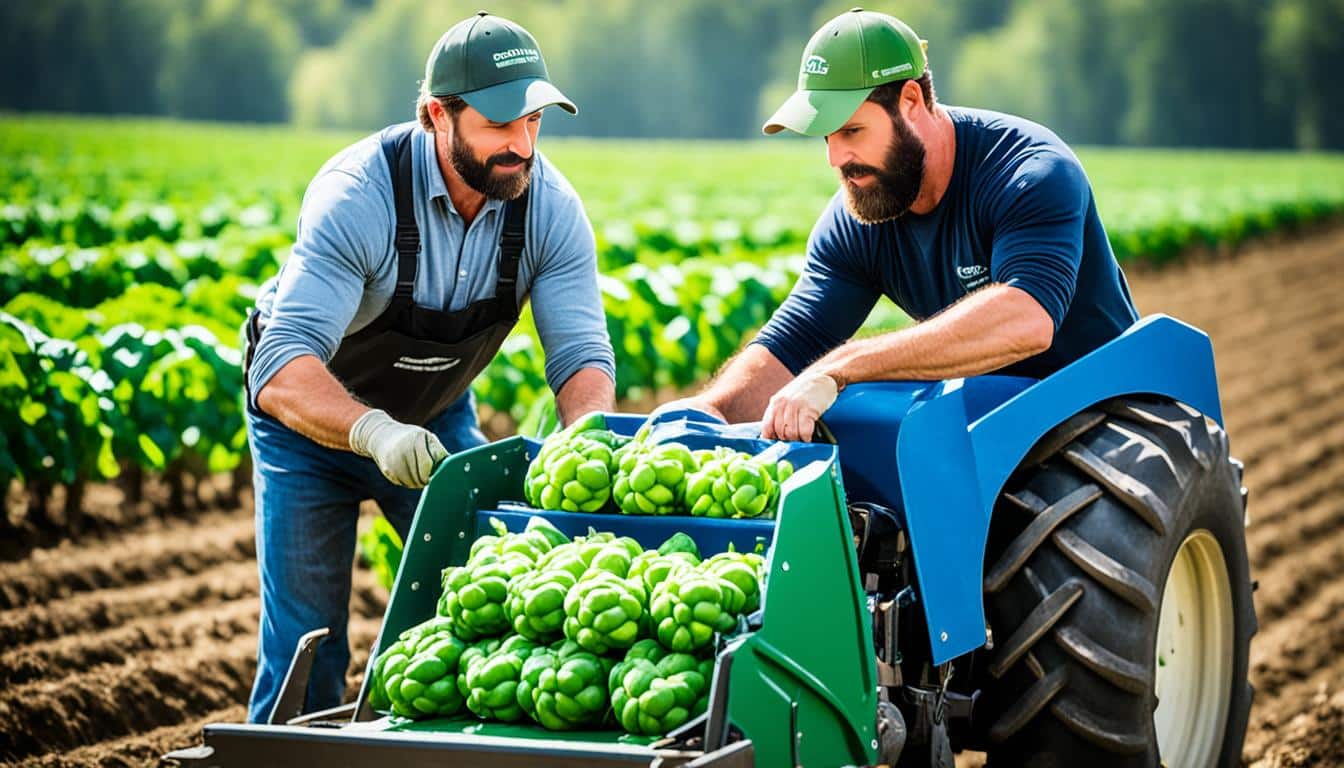
Have you heard about work-related musculoskeletal disorders (WMSDs)? They are the top cause of disability for workers. These issues are common in farming, leading to back pain and pain in the shoulders, arms, and hands. In California, each year, over 3,000 farm workers claim back injuries that cost more than $22 million in workers’ compensation. So, it’s vital to use better ergonomic practices in farming. They benefit both the workers and the farm’s long-term success.
Farming is known for being physically tough. The tasks often require movements that strain the body, leading to injuries like sprains and back problems. A big part of these injuries keeps workers away from work. This shows the crucial need for ergonomic solutions in farming. Such changes can lower injury rates, increase work efficiency, and cut costs. Matching the right tools and methods to workers is key. It helps keep them healthy and the farm running smoothly.
Ergonomics is key in making workspaces better for workers, which cuts injury risks and boosts efficiency. In farming, ergonomic techniques are vital because the work is tough, with lots of repetitive and hard tasks. By using ergonomic solutions for farming, workers feel better and get more done.
Ergonomics is all about making the work environment suitable for the worker. It’s not forcing the worker to adjust to the job. This means changing tools, tasks, and spaces to make work easier and prevent injuries. In farming, this is extra important because the work includes doing the same movements a lot, lifting heavy things, and staying in strange positions for a long time.
Ergonomics matters a lot in farming because it’s risky. Agriculture is the second most dangerous job when it comes to injuries, deaths, and sickness. Musculoskeletal disorders (MSDs) are common and painful among farm workers. But choosing the right ergonomics in farming, like using smaller containers for grapes or long hoes, can help. These changes make work less painful for workers.
In farming, many ergonomic problems come from bending over, lifting heavy things, and using hands a lot. This leads to a lot of musculoskeletal disorders, especially back pain among farm workers. Working the knees too much can lead to knee problems, and being around machines can also be dangerous due to the fumes and vibrations. But, using the right ergonomics helps a lot. For example, machines that cut with air and making orchard ladders safer make a big difference.
| Ergonomic Interventions | Impact |
|---|---|
| Smaller tubs for grape harvesting | Reduced back strain |
| Extended-handle carriers for potted plants | Minimized bending |
| Long-handled hoes for weeding | Less stooping |
| Pneumatically-powered cutters | Reduced hand strain |
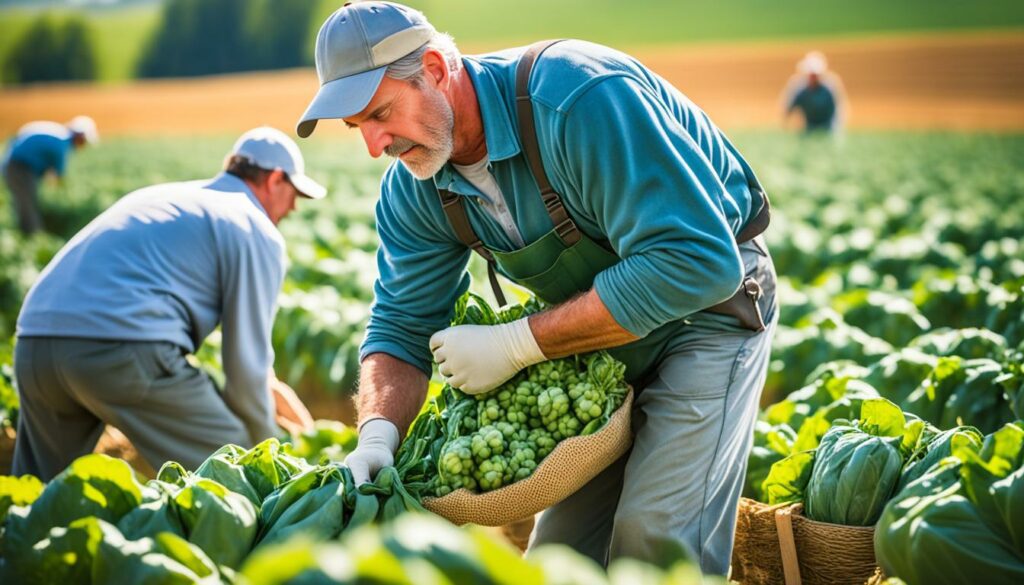
Farming tasks are hard work, often causing many physical strains. Workers often suffer from backaches, and pain in their shoulders, arms, and hands are common. These issues are a big part of farm work and need to be understood better.
In agriculture, sprains, and strains are top causes of injuries. They make up about one-third of all incidents. Back injuries are also significant, making up about a quarter of cases.
In California, over 3,000 back injuries a year can cost more than $22 million in workers’ compensation. These work-related musculoskeletal disorders (WMSDs) are a leading cause of disability. They affect many people during their working years.
Agriculture ranks second in occupational injuries and illnesses, after only construction. Musculoskeletal disorders (MSDs) are the most common non-fatal issue. Among them, low back pain is the most frequent, highlighting the need for better farming methods.
Farm work often involves heavy lifting, moving things, and bending a lot. These activities are key reasons for musculoskeletal disorders in farming. Certain jobs, like harvesting and operations in nurseries and greenhouses, are known to be more stressful.
Tasks that require a lot of hand movement and kneeling can increase the risk of conditions like osteoarthritis in the knees and hips. These risks are higher for certain rural workers, especially women and those who are obese. The way work is done in agriculture doesn’t always look after the body well.
But, there’s a solution. Ergonomic farming methods help reduce the risk of injuries. By changing tools and how work is done, workers can avoid physical strain. Implementing these methods can lower the chances of musculoskeletal disorders.
Even small changes using ergonomic principles can make a big difference. They can improve the health and productivity of farm workers. This approach isn’t just good for the workers; it’s also good for the business.
| Common Injuries | Percentage | Annual Cost (California) |
|---|---|---|
| Sprains and Strains | 33% | $22 million |
| Back Injuries | 25% | |
| WMSDs | Leading Cause |
Farming needs to focus on ergonomic practices to keep workers safe and productive. Backaches, shoulder, arm, and hand pain are common among farm workers. It’s important to use ergonomic solutions to tackle these issues.
In California, more than $22 million is spent yearly on workers’ compensation for back injuries. These include sprains and strains. Improving farming ergonomics can cut these costs. This involves changing tools and how work is done.
Issues like work-related musculoskeletal disorders (WMSDs) lead to disability. They’re caused by tasks that require lots of force or repetitive movements. Changing job positions, tasks, or tools can stop these problems happening. Also, these changes make work safer, more comfortable, and productive.
To farm ergonomically, make things easier to reach and tasks less repetitive. This involves changing how tasks are done or the tools used to suit the worker’s body better. For example, keep items within 17 inches to avoid reaching too far. And, have some tasks done while seated to ease back and leg strain.
Ergonomic steps can also cut down on sprains and strains. Try to keep lifting below the shoulder level and lift closely to your body. These tweaks not only prevent injuries but also make work positions better and reduce how much force is needed.
| Category | Ergonomic Adaptations |
|---|---|
| Hand Work | Position items within 17 inches, provide seated jobs |
| Tool Design | Ensure proper grip sizes, non-slip materials |
| Lifting | Keep lifts between hand and shoulder, redesign loads |
| Job Redesign | Avoid stooped work, use long-handled tools |
By adopting ergonomic farming techniques, the physical strains of farm work can be lessened. This significantly drops the chance of injury and looks after workers’ health. These practices not just better farming ergonomics but also help in making farming more sustainable and productive.
Hand work in agriculture can be much better by using ergonomic ideas. This means thinking about where tools are and mixing tasks to avoid doing the same thing over and over. It also involves using chairs and seats designed to keep farmers comfortable. These steps lower the risk of getting hurt or tired.
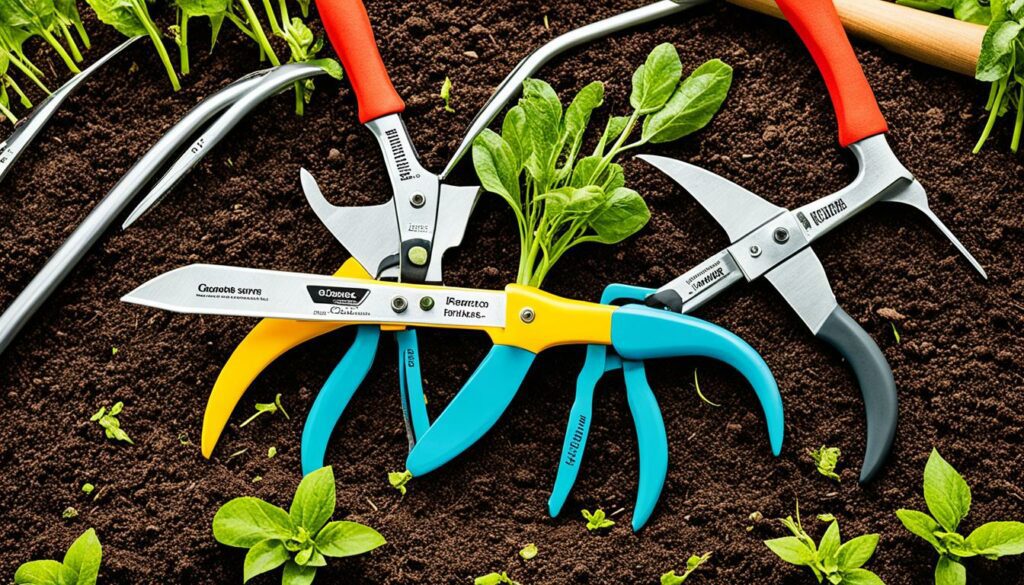
Putting tools in the right place is key to keeping farmers healthy. Tools should be set up so they’re easy to grab and not too high. This stops farmers from reaching too far and helps them avoid hurting their backs.
One big help is changing jobs often. Doing a mix of activities can stop muscle pains and injuries. It’s a smart way to lower the chance of getting hurt over time. This is especially true for issues that can happen from the same movements again and again.
Having the right chairs in farming makes a big difference. Designing seats that fit well for both sitting and standing work is important. It also means adding mats for comfort and to help with tiredness. These simple changes make a farmer’s day easier and safer.
show how important ergonomics is for farm safety. By following these steps, farmers can work better and avoid getting hurt. This saves money and keeps everyone well.
| Statistic | Details |
|---|---|
| Common Symptoms | Backaches and pain in shoulders, arms, and hands |
| Injury Causes | One-third sprains and strains, one-quarter back injuries |
| California Case | Over $22 million in annual workers’ compensation costs |
Farm work often means lots of lifting, causing backaches, and pains in the shoulders, arms, and hands. It’s important to use the right ergonomic lifting techniques to keep workers safe. This part will show how to lift things the right way.
It’s key to lift safely. Ergonomic rules say to keep lifts between hand and shoulder level to avoid strain. Don’t lift from the floor or over your shoulders. Keeping loads close, within 17 inches from your body, cuts down on how hard lifting is.
Using the right equipment for safe lifting is crucial in improving ergonomics in farming. Dollies, pallet trucks, and containers with handles make lifting safer. Mechanical aids make work easier, boost productivity, and keep workers happier and healthier.
“Implementing ergonomic improvements in farm work not only reduces injuries but also enhances worker productivity and morale.”
| Ergonomic Guidelines | Benefits |
|---|---|
| Keep lifts between hand and shoulder level | Reduces strain and risk of injury |
| Use mechanical aids like dollies and pallet trucks | Minimises manual handling |
| Redesign loads for closer lifting to the body | Improves safety and efficiency |
| Provide handles on containers | Facilitates easier and safer lifting |
Many farm workers suffer from backaches and pain in their arms and hands. These issues often come from stooped work. This type of work puts a lot of stress on the body. In California, over 3,000 back injuries a year cost more than $22 million in workers’ compensation. By changing how jobs are done and using ergonomic techniques, we can cut down on these injuries.
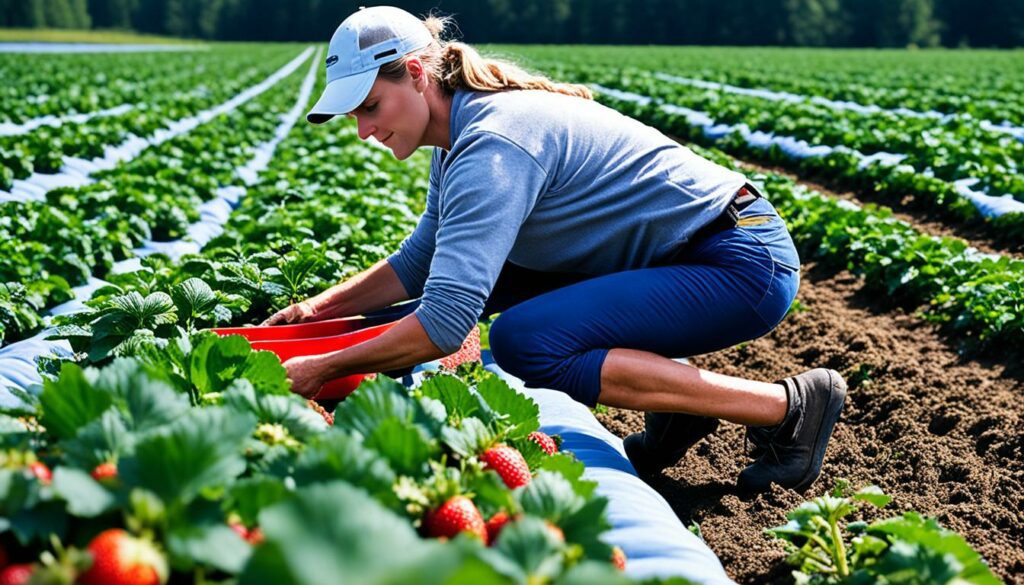
We need to design jobs well to stop people from stooping too much. This means using tools with long handles and giving workers stools. It also involves planning tasks so people don’t have to stoop a lot. By placing work items smartly and keeping materials at waist height, the risk of back injuries goes down.
Adding short tasks that let workers stand or sit can help a lot. This gives them breaks from stooping, making work more comfortable and safe.
Using the right tools can make stooped work less hard on the body. For example, tools with long handles help workers stand up straight. This stops their back from getting too tired. Adjustable stools let workers sit sometimes, which reduces how much they need to stoop.
Working closely with farmers and employees, we can find simple and cheap solutions. These solutions help prevent injuries like sprains. Using these ergonomic tools could greatly lower the number of issues farm workers face in their muscles and bones.
Hand tool ergonomics is key to stopping strain and making farm work comfier. The size and material of the handle matter a lot. They lower the chance of getting hurt.
The perfect handle size lets workers hold tools tightly and comfortably. They should fit the forefinger and thumb well. Handles are best when they let fingers touch but don’t completely wrap around. For most hands, a 1-3/4” size is a good choice, but sizes from 1-3/8” to 2-1/8” are needed for different hand sizes.
It’s about making sure tools can be used by anyone without causing stress or strain.
The materials of the handle matter too. Rubber or plastic handles are better because they don’t slip. They make holding tools easier and more comfortable. For tools you use with both hands, the handles need to be 4-5 inches long and have a spring. This spring lets the tool stay partly open, which helps avoid hurting your hands from constant use.
| Handle Size (inches) | Hand Size | Material |
|---|---|---|
| 1-3/8 to 2-1/8 | Small to Large | Rubber or Plastic |
| 4 to 5 (length) | Dual-handled tools | With spring return |
Farming is hard work, often leading to aching backs and sore arms. The right ergonomic equipment for farmers helps ease these issues. It’s made to keep workers safe and comfy while they work.
Special carts for gathering crops cut down on the need to bend and lift. This helps lessen the risk of back and shoulder pain.
Workers can adjust their workstations to match their own body. This helps stop muscle and bone problems.
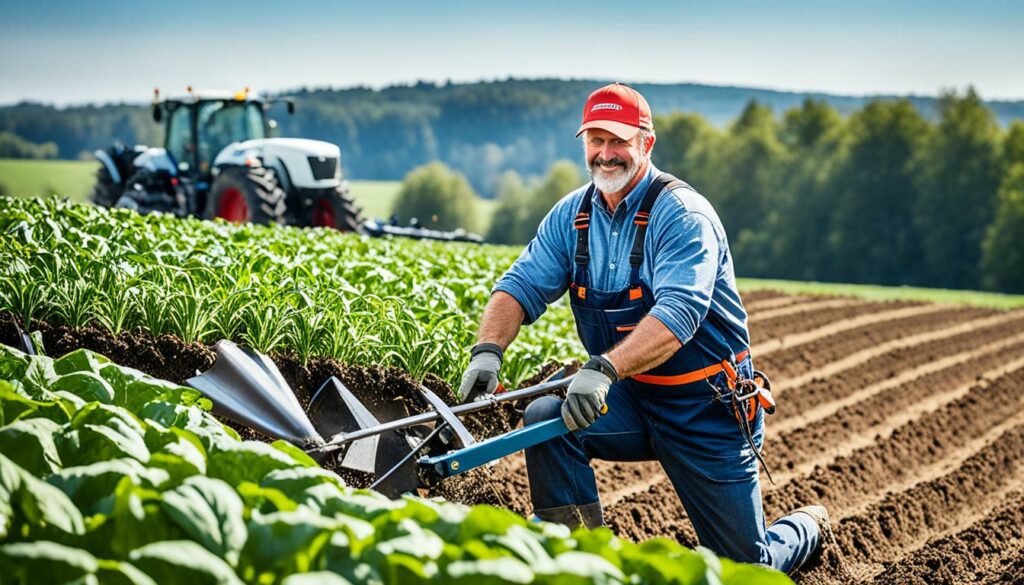
Tools with good grips and placed close to the body are key. They should fit well in your hand and be easy to reach. This helps avoid hurts from doing the same movements over and over.
Encouraging alternate tasks that do not require repetitive hand motions is another effective method to reduce injury risks from high repetition activities.
Sitting down to work can also cut down on leg and back problems. This is because you’re not standing all day. Seated jobs should be set up just right for each person, to keep them comfy and their work good.
Good ergonomic farming not only makes work better, but it also helps work be done well. It’s a good way to invest in the future of farming. This is by keeping workers happy and safe, and by keeping the farm going strong.
| Ergonomic Equipment | Advantages | Implementation |
|---|---|---|
| Specialised Harvesting Carts | Reduces bending and lifting | Use for all harvesting tasks |
| Adjustable Workstations | Accommodates various body types | Customise height and position |
| Ergonomic Tool Handles | Comfortable grip, reduces strain | Ensure proper handle diameter |
| Seated Workstations | Reduces lower back and leg strain | Use for repetitive hand tasks |
In agriculture, using vehicles is essential. It’s key to keep farmers healthy and productive to look at ergonomics. This includes lessening vibrations and creating comfortable, supportive seats. Let’s explore how to make using vehicles in agriculture more ergonomic.
Lessening vibration in farming vehicles is vital. Long exposure can worsen muscle and bone issues. Advanced seats with special features reduce this effect. For example, modern tractor seats help keep farm workers safe from the harm of daily vehicle use.
The importance of these new seats is backed by real numbers. In California agriculture, over 3,000 back injuries per year cause more than $22 million in workers’ compensation. This high cost shows why we must reduce vibration in farm vehicles.
The right design for a farmer’s seat is crucial. It must be comfortable and lower the risk of injury. A perfect seat design gives lots of ways to adjust and strong support for the lower back.
This can stop injuries by making work postures better and lowering the strain from using farming vehicles. Buying seats with many adjustments and good back support is vital. It’s not just for comfort but for keeping farmers healthy in the long run.
Ergonomic vehicle use is about more than preventing harm. It aims to make farm work safer and more comfortable. This not only benefits farmers but also their productivity and well-being.
Sustainable ergonomic farming practices aren’t just about new tools. They’re a whole system. This includes good management, involvement from workers, and a push to always do better. The goal is to make work safer and more efficient. This helps both the workers and the farm itself.
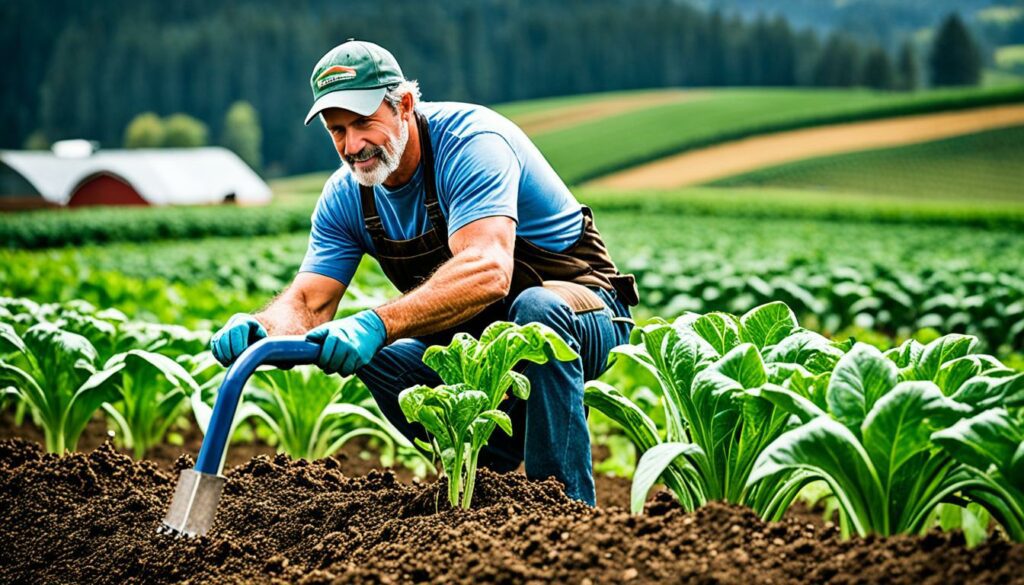
Using ergonomic methods in farming can cut down on muscle and bone issues, known as WMSDs. Nearly half of all these cases come from lifting wrong. Changing how tools and tasks are done can lower the chance of these injuries. In places like California, this change could save a lot of money spent on injuries each year.
Taking care to avoid too much reaching, bending, or lifting helps stop injuries like strains or sprains. Following simple rules can make a big difference, like making sure tools are at the right height and keeping important items close. Plus, getting help early and making smart job changes can prevent some health issues.
Agriculture is full of risks, especially for job-related injuries. So, it’s key to adopt good ergonomic practices. These methods are all about making the farm better and safer for the long haul, matching the job to the worker well.
There’s proof from studies that using ergonomic methods works. For example, changing grape collecting tubs to be smaller has helped a lot. It’s small steps like these that can make a big impact on the health of farm workers.
So, ergonomic farming isn’t just about now. It’s about building a farm that’s strong. This means caring for the workers and making the farm work better over time.
In agriculture, participatory ergonomics brings together workers and managers. They work to find and fix problems in how tasks are done. This approach uses workers’ real-life knowledge to create solutions for each job’s challenges. It makes workers feel they are part of making things better.
Participatory ergonomics is key in handling the unique problems on farms. For example, in Korea, a study looked at nine male farmers aged 59 to 78. They found many of these farmers faced health issues like back pain and knee problems. These were often because of doing the same tasks over and over and lifting heavy things.
Trained workers checked if new methods were helpful using tests like RULA and questionnaires. They wanted to see if changing how they worked made things safer and easier. The results were good. Workers felt they had less strain, knew more about staying safe, and were happier with their jobs.
Having workers help decide how to improve makes sure the steps taken are realistic and doable. This teamwork doesn’t just better ergonomics; it also improves worker happiness and cuts down on injuries. Everyone wins – the workers, the farm, and the business.
Participatory ergonomics is a team effort that changes how farming is done for the better. It cuts down on health issues like MSDs and helps farms last longer. It’s a win for everyone involved in farming.
It’s important to think about how farmers work with specific crops. Each task can put a different kind of strain on the body. Finding the right tools and methods for each crop can help reduce the chance of health problems like MSDs.
Picking fruits can be hard on the body. But, there are ways to make it easier. Using smaller containers can lighten the load. Special carts can help too, making it easier to pick without bending too much.
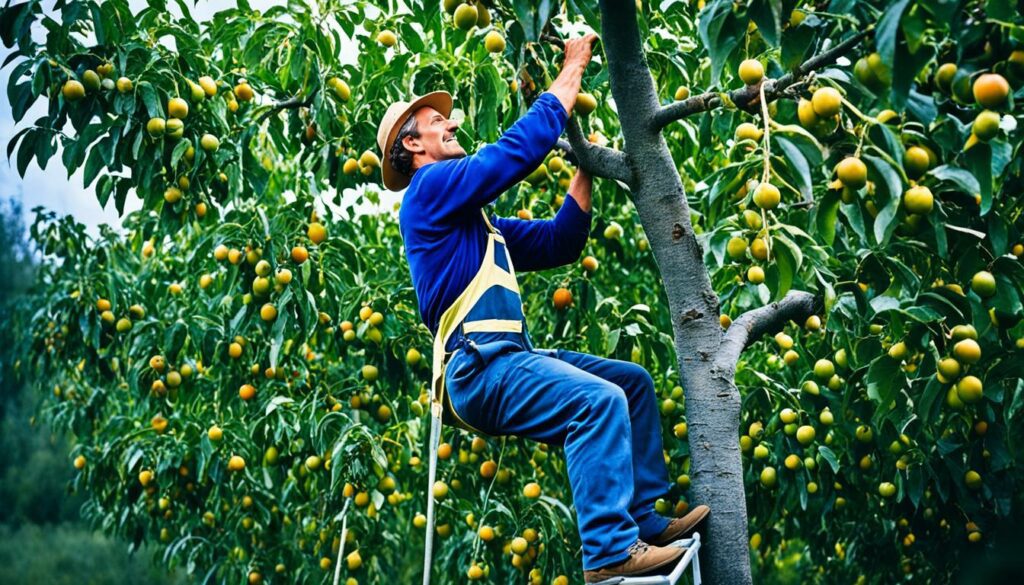
Lifting heavy things over and over can hurt the neck, shoulders, and back. Tools like long-handled cutters and adjustable platforms can make this job safer. And, they can help workers pick fruits faster.
Working in nurseries also has its risks. Carrying potted plants and cutting can strain the body. That’s why using tools like extended-handle carriers and power cutters can help. They make heavy work easier.
Making places to work without needing to stoop is good for the back. This can help avoid the common MSD of low back pain. Taking breaks from bending over can also prevent pain.
Using special tools and setups for each crop is key. It protects the health of farmers. And it helps farming stay sustainable and productive.
Ergonomic farming isn’t just about lowering injury risks. It offers many long-term gains by making tools, methods, and workplaces better. This helps farmers in several big ways.
When farms use ergonomic methods, workers feel more comfortable. They are more efficient, making the farm more productive. This means workers don’t get as tired or hurt easily, keeping them working well. The farm produces more this way and workers stay healthier.
Giving farm workers better tools and conditions boosts their mood. It also makes the farm a happier place to work. With the right ergonomics, workers are healthier and happier, taking fewer sick days. They work together better and stay more interested in their jobs.
By using ergonomic methods, farms can cut down on injuries and health issues. In California, back injuries alone could cost more than $22 million a year. With fewer injuries, farms spend less on medical care and compensation. Saving this money is a good reason to go ergonomic.
Adopting customising ergonomic solutions for farming varies with each operation’s needs. Because each farm task is different, it’s vital to use farming methods that ensure workers are safe, comfortable, and productive. Injuries like backaches happen often, making up a third of all farm work injuries. In California, these back injuries cost over $22 million every year in compensation.
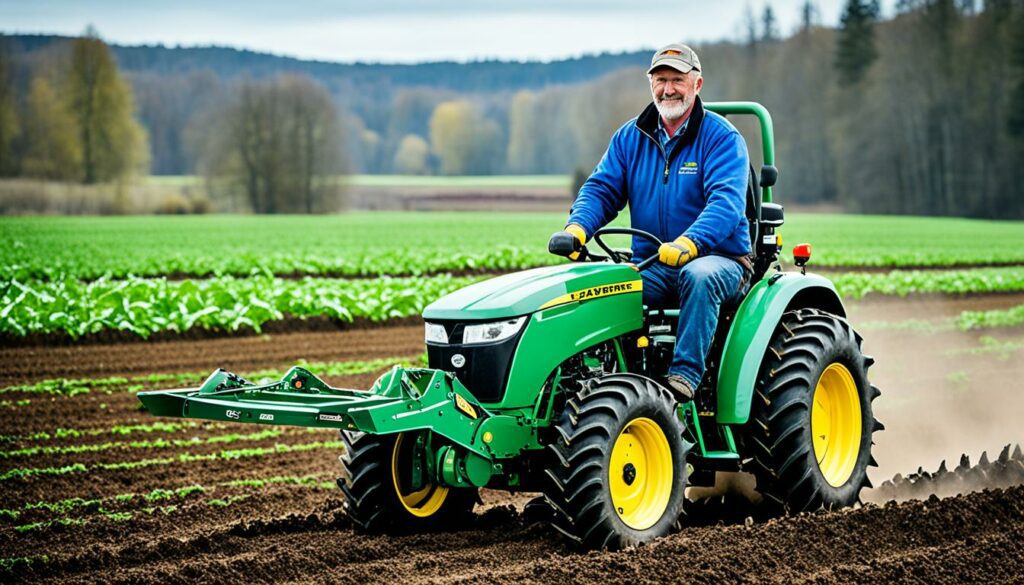
Farmers often work in ways that strain their bodies, like when they bend a lot, lift heavy things awkwardly, or do the same tasks over and over. Special ergonomic methods for farms help prevent these strains. This means making smart changes to farming tasks, tools, and workplace design.
By looking closely at what specific farm jobs require, ergonomic ideas can fit right in. For example, making tools easier to use or adding machines to help lift heavy stuff can cut down on injuries. This makes the work easier and safer for workers.
Teaching workers about safe ways to do their job is very important, too. Understanding how adaptable ergonomic farming practices work helps them stay safe and do a better job. In the end, using the right ergonomic tools and ways of working can make farming a much safer and efficient place to be.
In farming, using sustainable ergonomic methods is crucial for both better productivity and worker health. It ranks second in job injuries, showing we urgently need ergonomic help. The most common non-fatal illness is musculoskeletal disorders (MSDs), with lower back pain being a big issue.
It’s key to see why agricultural ergonomics is so important. Many farm workers face issues like knee and hip osteoarthritis, worsened by things like age and obesity. Luckily, ergonomic tools have started to lower MSDs’ impact. For example, tools like smaller tubs for grapes and orchard ladders with closer rungs are making work easier and safer.
When farms work together, they can make big changes. They can use tools like extended-handle carriers and give workers more breaks. These changes help a lot. Between 2010 and 2019, studies showed we’ve come a long way, but there’s still more we can do.
To sum up, focusing on tailored ergonomic solutions is making a big difference. By using practical ideas and backed-up research, we’re seeing how helpful this approach is. It helps farming stay strong for the future.
Ergonomics focuses on making work environments better for the people in them. It aims to make work easier and safer. In farming, this means adjusting tools and how things are done to help workers stay healthy.
Farm work can be tough on the body. Ergonomics helps farmers avoid getting hurt doing common tasks. It makes their jobs less risky and their work easier.
Some tasks in farming, like lifting heavy things or doing the same movements over and over, can hurt the body. These can cause muscle strain and long-term pain in the back.
Farms can be places where you often need to lift, bend, and do the same actions a lot. This can lead to strains and injuries in the back or arms.
Ergonomic farming changes how jobs are done. It can mean using tools that fit better or sharing tasks to avoid doing the same thing all the time. This reduces the risk of injury.
Making hand work in farming easier can involve placing tools within easy reach. Also, doing different jobs to give muscles a break and using tools that are easy to hold help.
To lift better, it’s good to keep the load near your body and not too low or high off the ground. Using tools with handles or machines that can help you lift are also smart choices.
If your work involves a lot of bending, using tools with long handles or seats to take breaks can help. Mixing tasks that require standing or walking also reduces pressure on the body.
Hand tools must be easy and safe to hold. They should fit your hand and not slip. For tools you use with both hands, they should be long enough to use comfortably.
For those in farming, there are adjustable work areas and tools designed with comfort and safety in mind. This equipment can make tasks easier and reduce the chance of injury.
Vehicles used in farming can be made more comfortable by having seats that reduce shaking and support your back. This helps farmers’ bodies when they are driving for long hours.
Sustainable ergonomics involve a mix of quick fixes, good management, and workers helping find solutions. It’s all about keeping farm workers happy and farms running well for the long run.
These programs bring together farm workers and their bosses to make work safer and more comfy. They find and put into action ways to make jobs better, making everyone feel more involved and happier.
For different crops, there are tools and setups designed especially for that type of work. For instance, in growing plants, using stands that are just right or special tubs for picking can make jobs easier and safer.
Using ergonomics in farming means workers are healthier, happier, and more productive. This leads to less money spent on healthcare and a strong, efficient farm sector.
Every farm is unique, so what works on one might not on another. By looking closely at what each farm needs, ergonomics can make everyone’s work better and safer.